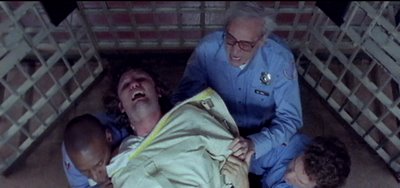 A scene from The Killing of John Lennon: the ex-Beatle’s body is taken to the morgue moments after he dies from gunshot wounds.
A scene from The Killing of John Lennon: the ex-Beatle’s body is taken to the morgue moments after he dies from gunshot wounds.***
Twenty-five years ago, on August 24, 1981, in a New York City courtroom, Judge Dennis Edwards asked Mark David Chapman if he had anything to say before he was sentenced for the murder of John Lennon. Chapman, who’d pleaded guilty to the crime (thereby avoiding a trial), chose to read a passage from J.D. Salinger’s The Catcher in the Rye, the book that he said inspired him to kill Lennon.
“Anyway, I keep picturing all these little kids playing some game in this big field of rye and all,” said Chapman, reading from the book, his faltering voice growing stronger and more confident with each word. “Thousands of little kids and nobody around—nobody big, I mean—except me. And, I’m standing on the edge of some scary cliff. What I have to do, I have to catch everybody if they start to go over the cliff—I mean if they’re running and they don’t look where they’re going I have to come out from somewhere and catch them. That’s all I’d do all day. I’d just be the catcher in the rye and all.”
This was Chapman’s message and confession. He was the Catcher in the Rye for his generation; he’d murdered John Lennon to save the little children.
Chapman then told the hushed courtroom, “I feel like a bloodied prizefighter in the 27th round.” These were the exact words he’d said to a psychiatrist in Hawaii after his suicide attempt. But nobody knew what he was talking about. They understood neither the significance of 27, the triple 9, nor the significance of Chapter 27, the missing chapter of The Catcher in the Rye, Chapman’s chapter written in Lennon’s blood. They were just the meaningless words of a madman, signifying nothing.
The judge then sentenced Chapman to 20 years to life in Attica prison, and the murderer was taken away in manacles. He walked fearlessly out of the courtroom, holding his head high, veritably glowing with pride. He’d done what he came to do—become the world’s most famous antihero.
This is, in part, how I described the courtroom scene in “Chapter 27” of my John Lennon biography Nowhere Man. I don’t know yet how the scene will be depicted in Andrew Piddington’s new film, The Killing of John Lennon, which premiered recently at the Edinburgh International Film Festival. (The film is unavailable in the United States at this time.)
But an accurate recreation of Chapman’s sentencing will presumably be in the movie—because it was Piddington’s goal to put onscreen an unflinching presentation of the truth, as seen through Chapman’s eyes, as he goes from his dead-end job as a security guard in Hawaii to the aftermath of the murder and his solitary confinement in Attica. All dialogue and voiceovers are based on the assassin’s journals, statements he made to the police and psychiatrists, interviews, depositions, and court transcripts.
Judging by press reports from Edinburgh, Piddington seems to have indeed created an uncompromising work of art and achieved a high degree of cinematic verisimilitude. The film has been described as documentary-like. The writer/director has also said that he wants The Killing of John Lennon to generate “controversy, adverse criticism and scorn.”
He can count on it. With scenes like the one in the picture above, showing the ex-Beatle’s body being taken to the morgue moments after he died from gunshot wounds, Piddington will have more than his share of controversy—primarily because a small but vocal army of self-appointed censors feel that Lennon’s killer is an unfit subject to explore in a film. Any movie about Chapman, they say, will give him the fame he wanted.
These censors, of course, have been in an uproar since they learned late last year that Chapter 27, starring Jared Leto as Chapman and Lindsay Lohan as a Lennon fan he befriends a few days before the murder, was in production. Well, now the censors don’t have to wait for the release of Chapter 27; the movie they’re dying to boycott is here now. (I can already hear the tap-tap-tap of a thousand hammers pounding nails into picket signs.)
The Killing of John Lennon, which has been in production for three years, and stars Jonas Ball as the murderer, seems to have snuck up on a press that has confined its Chapman biopic coverage to Leto’s gout and diet, Lohan’s asthma attacks and nightclub exploits, and Yoko Ono’s denunciation of Chapter 27, which, curiously, she also seems to be collaborating on.
The Killing of John Lennon appears to be everything Chapter 27 isn’t: truly independent, no bullshit, no stars, no interference from Ono, just the real story told as accurately as possible. It even has a straightforward title the producers made up themselves, rather than expropriating one from Nowhere Man.
Someday, I’d imagine, it’s going to make for one half of an enthusiastically picketed double feature.
